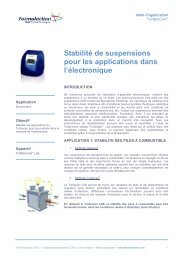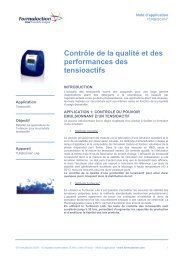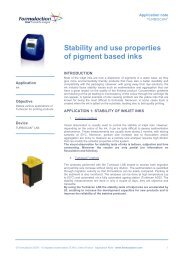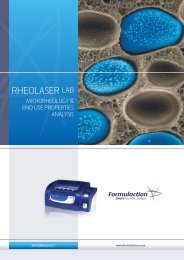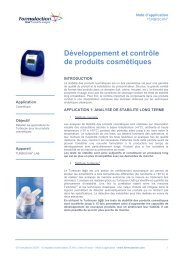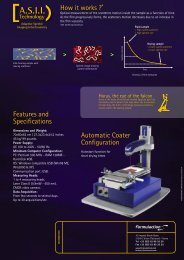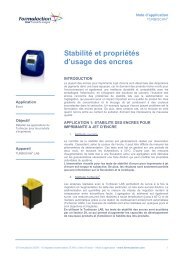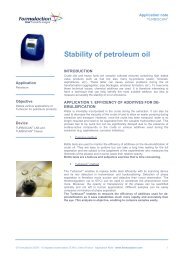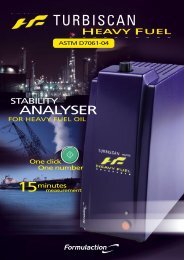Smart solutions for dispersions characterisation - Formulaction
Smart solutions for dispersions characterisation - Formulaction
Smart solutions for dispersions characterisation - Formulaction
You also want an ePaper? Increase the reach of your titles
YUMPU automatically turns print PDFs into web optimized ePapers that Google loves.
TURBISCAN is<br />
the reference <strong>for</strong><br />
stability analysis<br />
Turbiscan is used world-wide<br />
to detect at an early stage all<br />
kinds of destabilisation such as<br />
coalescence, flocculation, creaming,<br />
sedimentation, etc… Various<br />
products such as emulsions,<br />
suspensions or foams can be studied<br />
from low to high concentrations<br />
without any sample preparation or<br />
dilution.<br />
Stability kinetics and index are<br />
measured <strong>for</strong> an efficient sample<br />
analysis and comparison.<br />
Multiple Light Scattering<br />
Optical measurement of particles concentration and size<br />
MLS SOLUTIONS<br />
The Turbiscan works on Multiple Light<br />
Scattering in both Transmission (T) and<br />
Backscattering (BS) mode, in order to<br />
analyse low and high concentration<br />
<strong>dispersions</strong>.<br />
T &BS signals depend on particle size and<br />
concentration: BS & T = f ( d /ϕ)<br />
- Size range: 1 nm to 1 mm ;<br />
- Concentration range: 0.0001 to 95% v/v ;<br />
SCAN CONFIGURATION<br />
The Turbiscan acquires T & BS every 20<br />
microns along the sample height, thanks to<br />
a patented scanning reading head.<br />
Scans are repeated during sample ageing<br />
time to detect any variation of the signal<br />
due to a destabilisation, such as<br />
particle migration and/or particle size<br />
variation.<br />
Light Source<br />
(Near IR)<br />
Backscatter<br />
Detector<br />
Transmission<br />
Detector<br />
DATA REPORTING<br />
The software provides multi-level data<br />
treatment <strong>for</strong> both experts and nonexperts.<br />
- The Turbiscan Stability Index (TSI)<br />
is a one-click feature providing the key<br />
number depending on the global stability<br />
of the sample. It is a quick and easy way<br />
to characterize the sample, and enables<br />
the user to compare & rank various<br />
<strong>for</strong>mulations.<br />
- Kinetics computation based on the raw<br />
signal allows to identify and quantify<br />
in detail the phenomena taking place<br />
in the samples, depending on size and<br />
concentration variations.<br />
- The user can compute the evolution<br />
of the mean particles diameter or<br />
concentration during the ageing of the<br />
product in any part of the sample.<br />
Light Source<br />
Detector<br />
Light Source<br />
Detector<br />
BS=70%<br />
BS=35%<br />
Multiple Light Scattering<br />
STABILITY<br />
No variation of BS and T<br />
STABILITY<br />
PARTICLE MIGRATION<br />
Local peaks of variation of BS or T<br />
SEDIMENTATION<br />
CREAMING<br />
PARTICLE SIZE VARIATION<br />
Global variation of BS or T on the<br />
whole height<br />
COALESCENCE /<br />
FLOCCULATION<br />
3



